Uncategorized
Antisemitic attack against school bus reported in Chicago media didn’t happen, Jewish school says
(JTA) – Chicago Jews were alarmed Thursday as local news outlets reported that a bus full of Jewish schoolchildren had been the victim of antisemitic harassment.
Police were investigating after a group of adults had forced the bus to stop, made their way on board, and then delivered a “Heil Hitler” salute, according to the reports, which appeared in a wide array of Chicago outlets, including the Tribune and Sun-Times newspapers.
The story unnerved parents and triggered outcry among Chicagoans worried about rising crime and antisemitism at an especially tense time for American Jews.
But it wasn’t true, according to the CEO of the school whose students were involved.
“This is the definition of a fake story,” Rabbi Menachem Levine, the head of Joan Dachs Bais Yaakov – Yeshivas Tiferes Tzvi elementary school in West Rogers Park, told the Jewish Telegraphic Agency Friday. “I literally had a media incident for nothing.”
The saga raises questions about how antisemitism watchdogs call attention to the incidents that American Jews report. The story landed in the papers through the advocacy of the Simon Wiesenthal Center, which sent a press release Thursday noting that the incident took place on the anniversary of Kristallnacht, the 1938 pogrom that marked a turning point in the Nazis’ campaign against the Jews of Europe.
The center had been contacted by a Chicago parent whose child reported that a man had made a Nazi salute during a conflict with the children on his bus. The parent also filed a report with the Chicago Police Department.
What actually happened, Levine said, was unnerving but not antisemitic. According to a video of the incident which he said he reviewed, the elementary school-aged kids had been calling out of the school bus at a group of men on the street, saying they looked like they were “mafia guys.” One of the men flagged down the bus, and the bus driver, acting against protocol, opened the door; the man then yelled an expletive at the kids, warning them to “watch what you say.”
While this was happening, Levine said, “the kids are laughing their heads off. They think it’s this hysterical thing.” Levine said he couldn’t share the video with the media because students’ faces are visible, but that he had also spoken to the students involved to confirm their accounts.
Afterward, however, one of the students reported to their parent that they had seen one of the men performing a Nazi salute; none of the other witnesses recalled such an act taking place. The parent, in turn, filed a police report and contacted the Simon Wiesenthal Center, which has played a prominent role in responding to multiple high-profile instances of antisemitism.
The organization reported the parent’s account of the incident to the media while linking it to the high-profile rise in antisemitism reported across the country.
“The Simon Wiesenthal Center is urging anyone with information about the anti-Semitic incident to contact the Chicago PD or the Midwest offices of the Simon Wiesenthal Center,” Alison Pure Slovin, the group’s Midwest director, said in the release.
The release led to a flurry of news reports that quickly circulated among Chicago’s Jewish community, which is centered on the north side of the city, where the incident took place, and in its northern suburbs. It ignited fear among families already on edge because of national incidents and reports about harassment of Orthodox Jews in New York City.
“We plan to send our kids to Jewish schools, and this is the biggest fear — things like this happening,” said Rebecca Finkel, a mother who lives within a 10-minute drive of the reported incident. “I’m the granddaughter of a Holocaust survivor. And in my mind, it’s not a question of if these things can happen, but which generation is going to be most impacted.”
All that left Levine, whose campus is the largest Jewish elementary school in the Midwest, in the position of trying to play catch up against what he said was a false news story as it spread rapidly through local and national outlets.
In an email to parents, he emphasized that “there was no antisemitic, threatening or racist behavior in the occurrence,” and continued, “We know there has been an increase in antisemitism recently, and we are all concerned about this. However, this occurrence was not one of antisemitism; the spread of misinformation is simply due to irresponsible reporting.”
Reached for contact, Slovin, the midwest director of the Simon Wiesenthal Center, told JTA that the center had relied on the parent’s report when they made their “statement of concern” to the media. (Most outlets that reported on the incident relied almost entirely on the center’s statement.)
She said she had spoken to two parents who filed police reports and also spoke to multiple police officers who were investigating the allegations. It is typical for officers to investigate reports of violence or harassment that are filed.
Slovin added that the Chicago PD told her organization that the incident was being investigated as a hate crime, but she acknowledged that the school itself “do[es] not believe it was antisemitic in nature.” The center had not retracted its press release on Friday.
While Levine said the center does “good work,” he said their handling of the bus incident was “highly irresponsible” and “a ‘boy who cried wolf’ case.”
The grandson of four Polish Holocaust survivors, Levine said that if there ever were an antisemitic incident at the school that required his attention, “I’ll be the first one to scream it out.” But he said he does worry that the false reports of the bus incident could encourage “one nutcase to read this and say, ‘Oh, I’ll show them real antisemitism’ — that’s all we need.”
Finkel, too, said she was concerned about the ramifications of a false report of antisemitism at a time when multiple indicators suggest that incidents targeting Jews are rising. The reports from her city broke during the “Never Is Now” conference organized by the Anti-Defamation League, a civil rights group that last year tallied more incidents of antisemitism in the United States than in any year since it began publishing annual counts in 1979.
“Antisemitism is so real and so dangerous and so pervasive,” Finkel said. “We don’t need to fabricate anything — we can rely on the truth to ask for allyship and to fight it in our own community. The truth is scary enough.”
—
The post Antisemitic attack against school bus reported in Chicago media didn’t happen, Jewish school says appeared first on Jewish Telegraphic Agency.

Uncategorized
Pardoned Jan. 6 protester Jake Lang throws chocolate coins, Nazi salute during anti-AIPAC demonstration in DC
(JTA) — Pardoned Jan. 6 protester Jake Lang staged an antisemitic demonstration on Sunday outside of the headquarters of the pro-Israel lobby AIPAC where he threw chocolate coins and gave a Nazi salute.
As he stood before a banner reading “Make Jerusalem Christian Again,” Lang made a series of threats against AIPAC-funded politicians and peddled a slew of antisemitic tropes, including the Great Replacement Theory, which holds that Jews are orchestrating mass immigration.
“White people in America, you will be replaced, and your children will be Black Muslims if you don’t stand up now,” said Lang, according to a video of the protest posted on X by journalist Ford Fischer. “AIPAC is one of the main components to the people at the head of Hollywood that are brainwashing your children to vote Democrat, to take your guns and to take your freedom. It’s time we fight back.”
VIDEO THREAD: Pardoned January 6er Jake Lang held a “Crusader” rally outside AIPAC Sunday afternoon, throwing (chocolate) gold coins at attendees dressed as politicians and suggesting “their Jewish money” has caused a “brownification of America.”
A couple counter-protesters… pic.twitter.com/CHsoj9ETu2
— Ford Fischer (@FordFischer) January 4, 2026
The demonstration hosted by Lang, who is currently vying for a Senate seat in Florida, comes as watchdogs have warned that alt-right figures are increasingly finding a foothold within mainstream conservative politics.
In recent months, far-right influencers like Lang, including livestreamer Nick Fuentes, have garnered mainstream attention within the Republican party, a trend that has sparked outcry among both Jewish and non-Jewish Republicans. But Vice President JD Vance has indicated that while he opposes antisemitism, he is not inclined to draw a line against rising antisemitism in his party. At the same time, AIPAC, which Lang targeted, has become anathema in both parties as support for Israel has plummeted in recent years.
Lang’s Senate candidacy in Florida is not considered serious. He has raised very little money in his quest to unseat an incumbent who has President Donald Trump’s support.
But Lang has benefited from Trump in the past as well. He had spent four years in federal custody in Washington, D.C., after being charged for allegedly beating a police officer with a bat during the Jan. 6, 2021, Capitol protest when Trump pardoned 1,600 people charged with crimes committed by his supporters that day. Earlier this year, he went free.
Since then, Lang has frequently staged incendiary protests in other cities across the country. In November, Lang travelled to Dearborn, Michigan, where he attempted to burn a Quran, the central religious text in Islam, and slapped bacon on it. (He later filed a lawsuit against the city claiming that police did not intervene in a confrontation with counter-protesters.)
During the protest Sunday, Lang also made a series of racist remarks towards immigrant children, including that “they’re anchor babies sent in as chemical weapons by the Talmudic Jews.”
Lang also warned that lawmakers who have received AIPAC donations would be “hung for treason.”
“Congressmen and women that have been taking AIPAC money, we suggest you stop now before the Crusades really start, you will be on the menu,” said Lang. “These people have sold our country out. Treasonous traders will be hanging from the gallows rightfully and just-fully prosecuted and hung for treason.”
Later, when asked by a person in the crowd whether he believed that “the Holocaust happened,” Lang replied, “Not at that level, no.”
Before leading his group away from the AIPAC headquarters, Lang gave a final Nazi salute and said, “That’s the APAC building right there. White Christian men are not gonna sit around while you turn our children into a bunch of n—er lovers.”
The post Pardoned Jan. 6 protester Jake Lang throws chocolate coins, Nazi salute during anti-AIPAC demonstration in DC appeared first on The Forward.
Uncategorized
She helped rescue the Torahs from their burning synagogue. A year later, Pasadena’s mishkan is thriving.
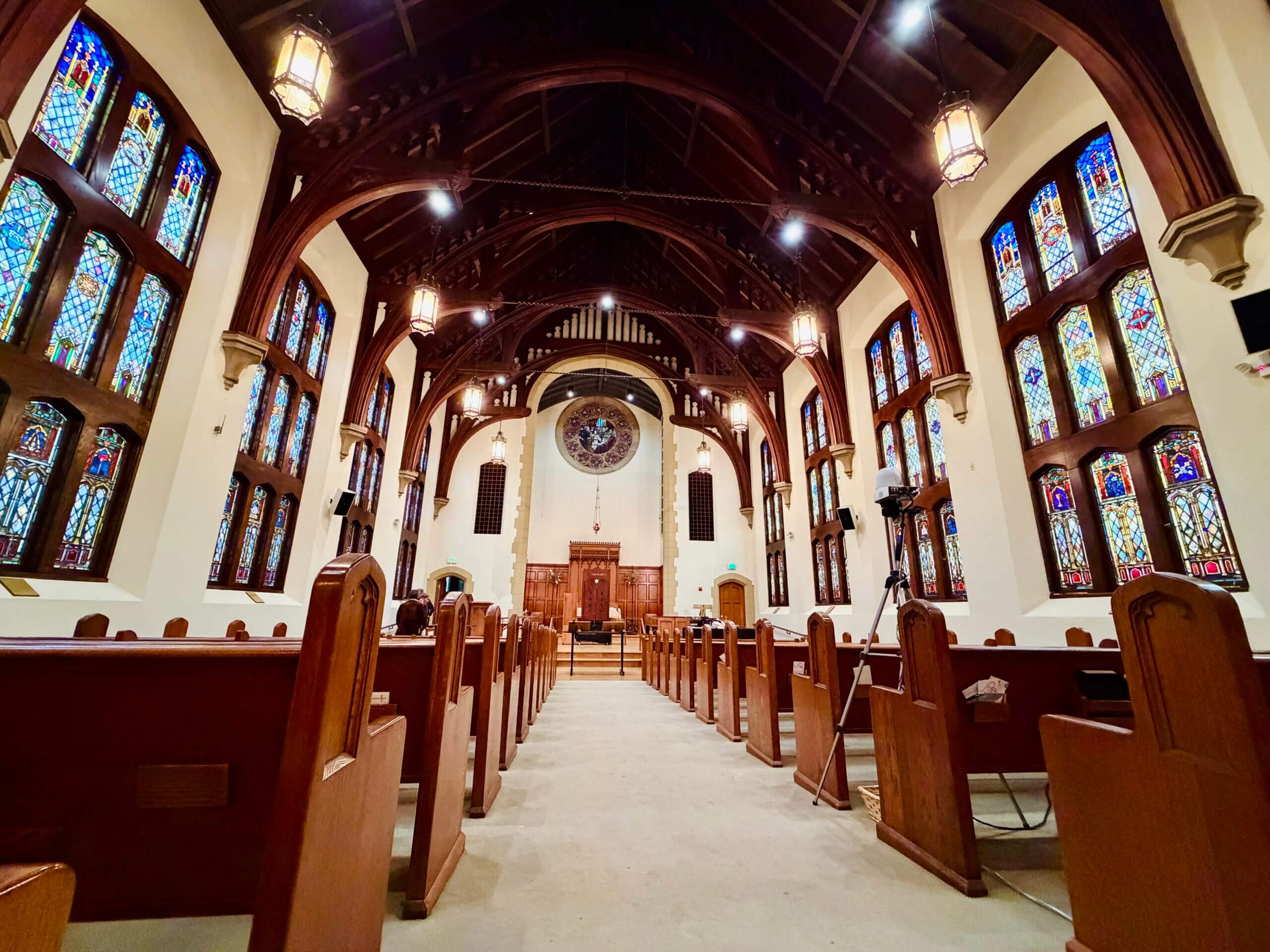
PASADENA — A year after fire reduced the Pasadena Jewish Temple and Center to ash, Cantor Ruth Berman Harris stands in the rain on the empty lot where it once stood. Beneath her boots, the ground is slick; above her, the San Gabriel Mountains fade into fog — the inverse of the dry, wind-driven night when flames tore through this block.
As smoke filled the building, and ash began falling in the parking lot one year ago, Berman searched for her husband through the darkness, calling out to make sure the Torahs were being carried out. Joined by the synagogue’s president and custodian, they worked quickly, loading the 13 scrolls into two cars as the fire, a beast consuming Los Angeles, roared closer. By night’s end, the building was destroyed, the flames claiming it all.
Over the past year, the synagogue has been doing the work of recovery in plain sight and in borrowed space. It has not seen a collapse in membership; as many families have joined since the fire as in the year before it. The calendar has remained full. In 2025, the shul celebrated 25 bar and bat mitzvahs — one nearly every other week — even as services moved to a church chapel across town. And as the community continues to grieve what was lost, leaders are already imagining a rebuilt synagogue designed to better reflect how the congregation lives and gathers now.
For Berman, 55, that rhythm felt familiar.
She grew up in Buenos Aires and lived through two acts of mass violence that targeted the Jewish community there — the 1992 bombing of the Israeli embassy and the 1994 bombing of a Jewish community center, which killed 85 people, including friends of hers. In those moments, she was the one making sandwiches for rescue workers, helping others absorb shock.
The Eaton Fire that razed Pasadena was different.
“What surprised me,” she said, “was how loving and caring and strong and vibrant a community can be in the midst of tragedy. There was no doubt that we were going to be OK.”
Over the past year, she has watched people return to Jewish life who had once drifted away from it — not out of fear, but out of need.
“It surprised me how relevant a Jewish community can be in times of crisis,” she said. “I knew it from books. I had never experienced it.”
Some losses, she knows, cannot be replaced. On her office walls hung artwork painted by her mother. On her desk, a constant presence was a prayer book she had studied from since cantorial school, filled with notes, highlights, and the handwriting of her teachers.
“I can buy another siddur,” she said. “But I can’t replicate their writing.”
She speaks plainly about the trauma. Nightmares. Compartmentalization. What she calls a lockbox she has learned to keep sealed so she can continue doing her job. Only recently, she said, has she begun to feel steady enough to open it — helped by the arrival of a permanent rabbi, and by the knowledge that the community is no longer just surviving.
A temporary sanctuary
Shabbat arrives inside a side chapel at the First United Methodist Church, where the Pasadena Jewish Temple and Center has been gathering since the fire.
During Sukkot, the church opened its courtyard for a sukkah. Shul congregants found themselves explaining the holiday — its temporary walls, its invitation to dwell with uncertainty — to church members who stopped to ask questions. What might once have been an accommodation became, instead, a point of exchange: Jewish ritual practiced openly, and neighbors eager to understand it.
The chapel feels like a sanctuary in its own right. There are no crosses on the walls. The space is rectangular and airy, with wood arches vaulting toward the ceiling like the hull of an inverted ship. Gold-rimmed stained-glass windows run the length of the room on both sides. One of them, inexplicably, bears a purple menorah.
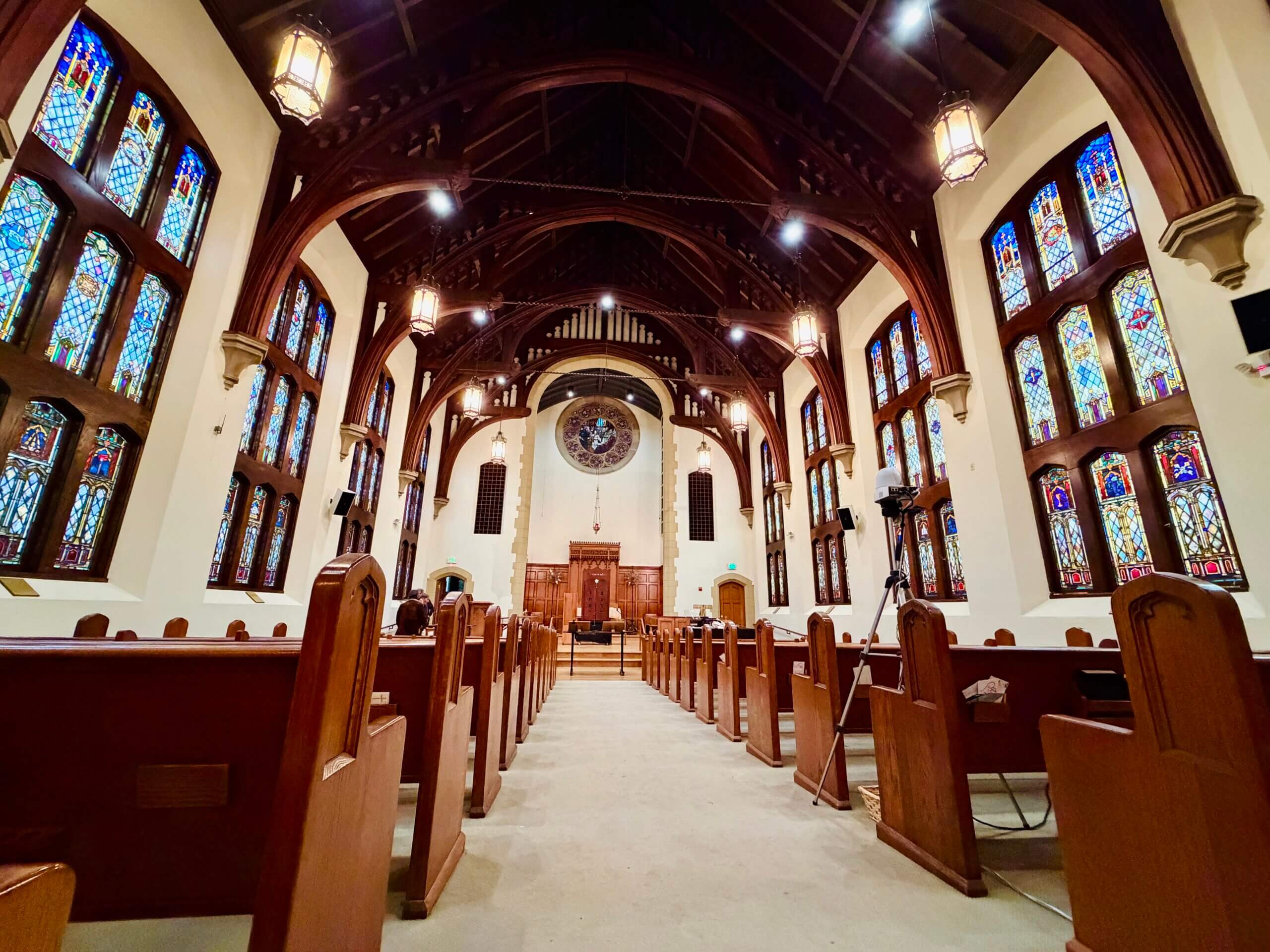
Only small details reveal the building’s Christian life: a New Century Hymnal tucked into the back of each pew, a Bible containing both the Old and New Testaments, a small tithing envelope resting beside it.
About 100 people fill the pews on Saturday morning. At the front of the chapel, Berman and Rabbi Joshua Ratner lead services alongside a bat mitzvah girl, while a guitarist and mandolin player keep the room humming.
The portable ark behind them has an unlikely backstory. It was crafted decades ago by a Los Angeles pediatrician (and father of Forward reporter Louis Keene) who had built it for his own shul which, at the time, was temporarily meeting at a Baptist church.
In recent years, the ark sat unused in the doctor’s garage. After the January 2025 wildfires, the family donated it to Pasadena — carried in and out of the church chapel each week, suddenly suited to a congregation without a permanent home.
For a year now, the Pasadena Jewish Temple and Center has lived this way. “It’s a mishkan,” Ratner said. “A traveling tabernacle.”
As the service continues, Ratner delivers the sermon. He began the job in August, months after the fire, at a moment when the synagogue no longer had a building to offer him — only a congregation in flux.
Ratner, 50, spent his early career as a lawyer before pivoting to the pulpit. He applied for the Pasadena job before the fire, drawn by what he had heard about the community. When the building was destroyed, he thought the search would be called off.
“I assumed that would be the end of it,” he said.
Instead, synagogue leaders doubled down. They wanted a rabbi not after recovery, but in the middle of it.
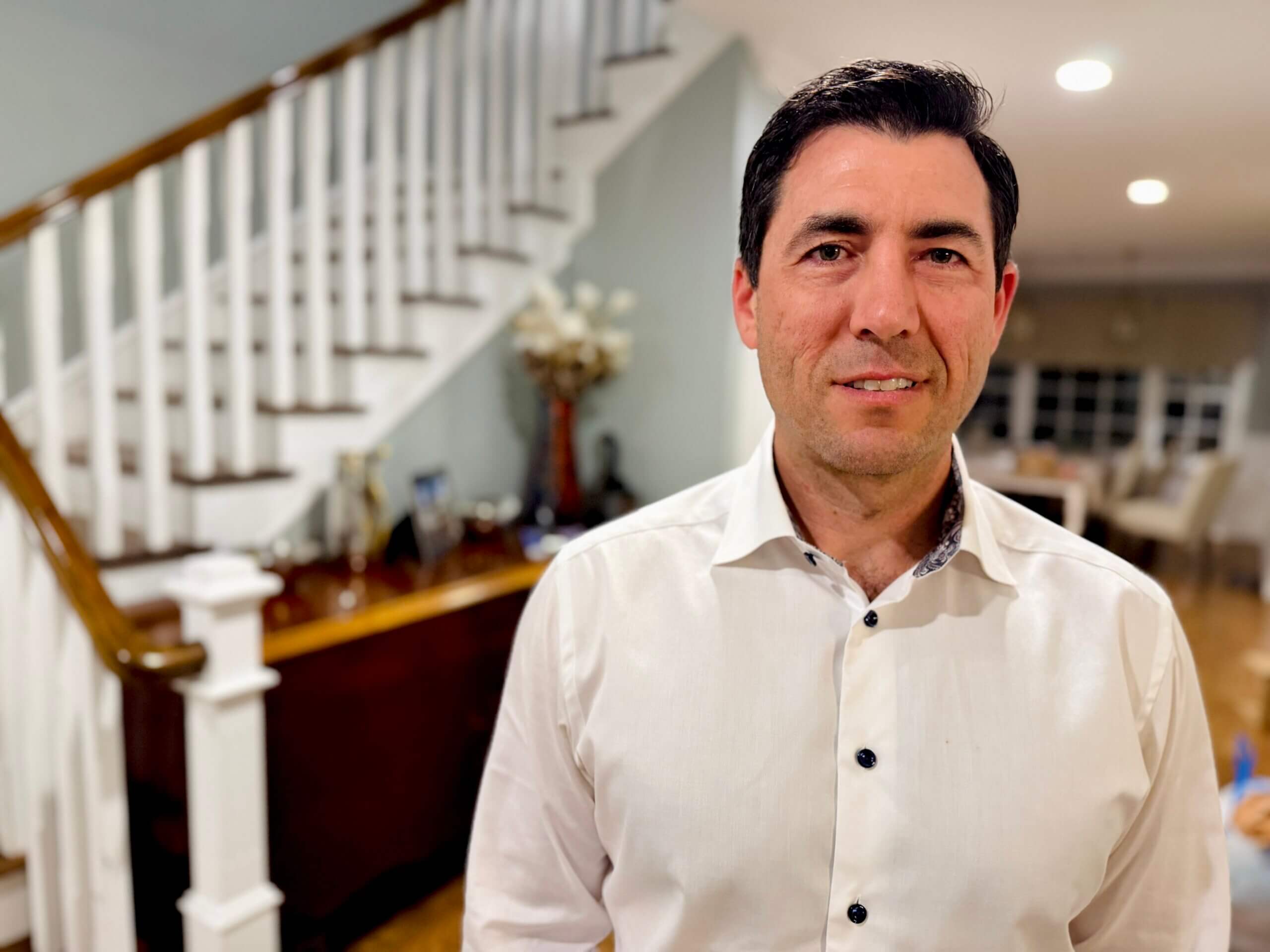
When Ratner visited Pasadena after the fire, he was struck by what he found. Hundreds of people filled Friday night and Shabbat morning services — not out of obligation, but solidarity.
The community, Ratner sensed, was grieving, but not frozen. “There’s no doubt or existential fear,” he said. “While we’re still mourning what we lost, we’re already morphing into the future.”
Since his arrival, the momentum has held. “Every week almost feels new,” Ratner said. “Like a simcha.”
A family without a home
For some of the shul families, the losses were not only communal.
In neighboring Altadena, Heather Sandoval Feng and her husband, Oscar, stand on the front steps of what used to be their home. The fire left behind a pile of rubble and a concrete staircase leading nowhere.
Three weeks after the fire destroyed their house, their daughter Hannah became a bat mitzvah.
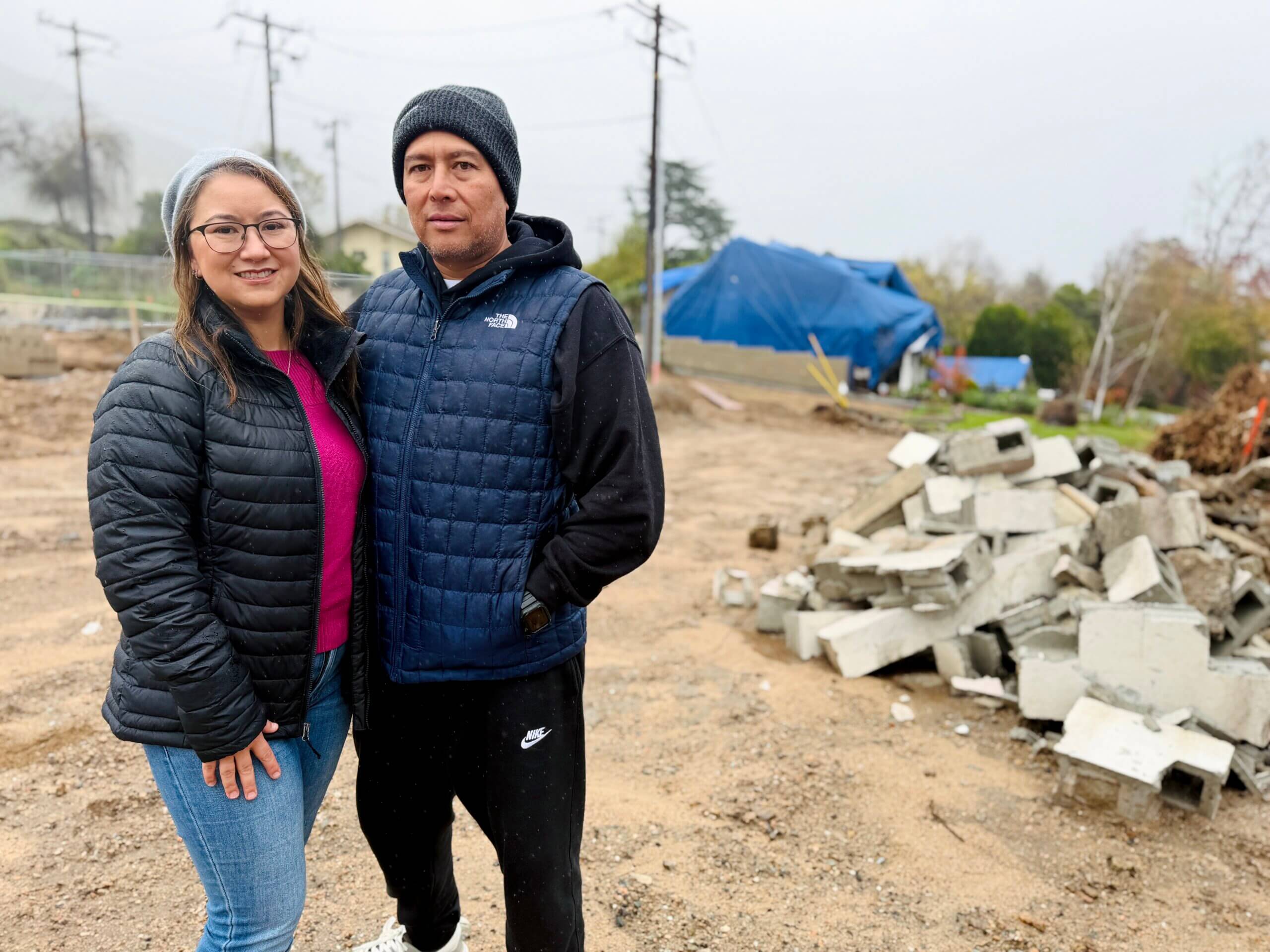
Like the congregation itself, the family was displaced. They moved in with Heather’s parents nearby. Life became provisional — borrowed bedrooms, borrowed routines, borrowed time. And yet Hannah’s bat mitzvah went ahead as planned, held in the church chapel where the Pasadena Jewish Temple and Center now gathers each Shabbat.
“There was something strangely comforting about that,” Heather said. “The synagogue had lost its home. We had lost ours. We were going through it together.”
Oscar described the year as one long exercise in adjustment — learning how to live without the assumption of permanence. “We’ve had to be a little nomadic,” he said, looking over as their son, Noah, 10, played in the dirt where his bedroom once stood.
The bat mitzvah ceremony became a life lesson — not just about Torah, but about continuity without certainty. “It turned into a teachable moment,” Oscar said.
What sustained them, both parents said, was the congregation’s steadiness. Tutors kept showing up. Shabbat kept coming. People checked in — not performatively, but persistently. The synagogue did not treat their family as a separate tragedy. It folded them into its own.
“There was never a question of whether things would still happen,” Heather said. “The answer was always: Of course they will.”
Holding steady and looking ahead
In the months after the fire, synagogue leaders worried about what displacement might do to membership. Instead of a drop-off, the numbers told a different story. Since the fire, the Pasadena Jewish Temple and Center has welcomed 49 new families — roughly the same number it added the year before. A handful of families have moved away, some because of the fire itself, but overall membership has remained remarkably consistent, hovering around 430 families.
An added bonus: Some relatives who flew in from out of town for bar and bat mitzvahs found themselves so moved by the congregation that they later joined it themselves.
What surprised Melissa Levy, the synagogue’s executive director, was not just the endurance, but the momentum behind it. Families kept calling. Local Jews who were not members wanted to now join the congregation.
“It’s amazing,” she said, “but it’s also a testament to how strong this community already was.”
That strength has been built over more than a century.
Founded in 1921 as Temple B’nai Israel, the congregation moved onto its current property in 1941, a campus of Mission Revival–style buildings arranged in a U-shape — a midcentury synagogue just beyond the urban sprawl of Los Angeles that had expanded over decades to include classrooms, playgrounds, and a social hall. At one point, it even had a swimming pool. During World War II, the synagogue hosted USO-style dances for servicemen stationed nearby.
Members have included NASA engineers, Caltech professors, and those who built their dreams among the stars. “I used to joke that growing up in Pasadena, our shul had doctors, lawyers and rocket scientists,” said Rabbi Alex Weisz, whose family has been members for generations.
As Jewish demographics shifted, the congregation absorbed others — merging with Shomrei Emunah and later Shaarei Torah — eventually becoming the singular Conservative synagogue serving the western San Gabriel Valley.
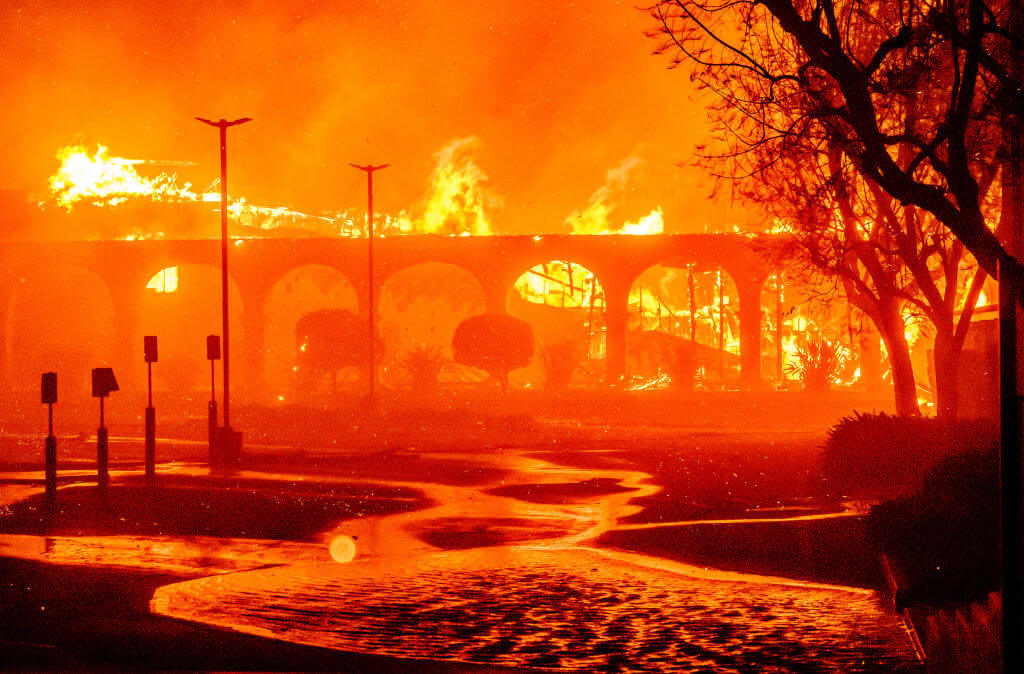
That history now informs the future, and what rises in its place will not be a replica of what was lost. The new building will be more intentional: fewer walls, more flexibility, and spaces designed around how congregants actually spend time together now.
Plans call for open gathering areas where parents can linger when their children are in classes — places to work, talk, or simply stay — rather than treating the synagogue as a drop-off point. There will be more glass and fewer corridors, designed to draw the San Gabriel Mountains into view. Outdoor areas are meant not just for overflow, but for prayer and meditation — quiet spaces that look outward, toward the hills that rise behind Pasadena.
“We were fitting a circle into a square,” Levy said. The new building is being imagined as a place where different generations can overlap rather than pass through on separate schedules.
The goal is not grandeur, but usability. A synagogue that can hold worship and study, celebration and stillness — and that reflects a community that has learned, over the past year, how to gather without relying on walls at all.
The scale of what lies ahead is substantial. Rebuilding is expected to cost tens of millions of dollars. Insurance will cover roughly half of that amount — money that was paid out quickly and is already in an account collecting interest — but the rest will need to be raised by the congregation itself. The cost is immense, especially for middle-class Pasadena, but leaders describe it as something to be faced, not feared.
They hope to open the new building by the High Holidays of 2028 — not as a return to what was lost, but as an expression of what the community has become. For now, those plans exist alongside grief. But Jewish life continues — weekly, seasonally, insistently.
Asked what it feels like to stand at the site of the fire a year later, Cantor Berman pauses.
“I don’t really have words for it,” she said.
Rain dots the cracked pavement beneath her feet, darkening the outline of the lot where the synagogue once stood.
After the fire — after the Torahs had been rescued and the building reduced to rubble — she returned to the site and took one small thing that was still standing. Not a ritual object. Not a book. It was the sign from her parking space — Reserved for the Cantor — something ordinary that had marked the rhythm of returning to the same place, day after day.
There were other losses, she said. Some she remembers clearly. Others she does not.
“The things I don’t remember having,” she said, “will haunt me forever.”
The post She helped rescue the Torahs from their burning synagogue. A year later, Pasadena’s mishkan is thriving. appeared first on The Forward.
Uncategorized
I grew up in Venezuela. Will Maduro’s ouster bring my Jewish community the security we need?
For Venezuelan Jews — inside the country and across the diaspora — the United States’ shocking removal of President Nicolás Maduro from power marks an inflection point in a long and painful chapter marked by vulnerability, fear and exile.
Venezuela was once home to one of Latin America’s most vibrant Jewish communities. I know this because I was raised there. A generation of Jews, including my own grandparents, found refuge from the Holocaust in Venezuela, at a time when many other countries closed their doors.
Venezuela’s relationship with the Jewish people was not only about providing a refuge for Jews following the Holocaust. It was also diplomatic. In November 1947, Venezuela voted in favor of United Nations resolution 181, which supported the creation of independent Jewish and Arab states in Palestine, leading to the creation of the State of Israel. For the Venezuelan Jewish community, this vote has long stood as a point of pride, and an affirmation of belonging.
For decades, Venezuela and Israel had a natural, mutually beneficial diplomatic relationship. For example, in 1961 the two signed a technical agricultural agreement as part of Venezuela’s push to modernize rural development.
High level visits between government officials between the two countries were common. I vividly remember shaking then-foreign minister Shimon Peres’s hand when he visited the Jewish Day School in Caracas in 1995 as part of a state visit. As a high school student, it was exciting to see firsthand how an Israeli statesman carved time out of his agenda to come see my distant country’s Jewish community. And, looking back, that visit underscored how normal and secure Jewish life once felt in Venezuela, in stark contrast to the fear and isolation that would follow years later.
All this began to change after Hugo Chávez came to power in 1999.
Under Chávez, relations with Israel steadily deteriorated, shaped by Chávez’s ideological commitment to global left-wing movements that, as a legacy of the Cold War, aligned themselves with Arab states and framed opposition to Israel as a core political stance. Diplomatic relations between the two nations were formally severed during the 2009 Israel-Hamas confrontation known as Operation Cast Lead.
That wasn’t just a major foreign policy shift; it also marked the onset of a political climate in which Venezuelan Jews felt increasingly exposed. That vulnerability reached a terrifying peak that same year, when armed assailants desecrated the Tiferet Israel synagogue in Caracas, ransacking sacred spaces; destroying religious objects; and scrawling threats and antisemitic slogans on the walls.
It was not an isolated act of vandalism. It was a message of hostility and intimidation, received as such by a community that already felt abandoned by the state.
In 2010, Chavez amped up his anti-Israel rhetoric in reaction to that year’s confrontation between the IDF and the Gaza Freedom Flotilla by declaring “maldito sea el Estado de Israel” — “cursed be the State of Israel” — on national television. When Maduro rose to power in 2013, following Chavez’ death, he did not reverse this trajectory. He accelerated it.
Under his rule, anti-Zionism repeatedly crossed into open antisemitism — both in language and in effect. Not long ago, while talking about Israel’s war in Gaza, Maduro claimed he had “real Jewish blood … unlike Israeli Jews” whom he described as “foreigners from Poland,” reviving classic tropes about authenticity, belonging and conspiracy that have long been used to delegitimize Jews and Israel.
After the Hamas attack of Oct. 7, 2023, Maduro’s regime openly embraced the “genocide” narrative against Israel. His government even compared Israel to Nazi Germany. The consequences of these statements touched Jews across Venezuela. Synagogues and Jewish institutions were often vandalized and defaced with hateful slogans. The targets were not Israeli diplomats — there were none — but Venezuelan Jews.
That distinction matters. Being Jewish has become more difficult in advanced democracies like the U.S. since the Oct. 7 attack. So imagine what it felt like in a country governed by an authoritarian regime that is openly anti-Zionist and routinely fails to distinguish between Jews and Israelis. The family and friends I still have in Venezuela navigate daily life with quiet caution, finding ways to remain Jewish while staying unnoticed, weighing every decision about when to gather, when to speak, and when silence feels safer.
But most of the Jewish community opted to be part of a wave of more than 8 million Venezuelan migrants — about 20% of the country’s population — who decided to seek a new life in other countries.
Will that wave of departures ebb now that Maduro has been forcibly removed from power by the U.S.? The honest answer is: we don’t know. Two decades of institutionalized hostility have left deep scars. And the early signs about the next era are discouraging. In her first televised addresses, new interim president Delcy Rodriguez — Maduro’s former second-in-command — blamed “Zionist” influences for the U.S. military operation. Old reflexes die hard.
And yet, Venezuelans, including Venezuelan Jews, are cautiously optimistic. Not celebratory. Not naïve. But hopeful that this may finally be the beginning of the end of a cruel dictatorship that devastated an entire nation — economically, socially and morally. If free and fair elections follow — still a significant “if”—Venezuela may have a chance to return to democracy, and with it, to its historical commitment to pluralism and coexistence.
That could also bring an opportunity to rethink Venezuela’s relationship with Israel — not only morally, but also strategically.
Israel could be a natural ally in Venezuela’s reconstruction. It is a global leader in water management, agriculture, health technology, cybersecurity, and energy innovation — precisely the areas in which Venezuela faces acute shortages after years of collapse.The building blocks are already there: Even amid today’s diplomatic wreckage, trade still exists at a small scale — evidence that the bridge can be rebuilt when politics allows it.
In fact, opposition leader (and 2025 Nobel Peace Prize winner) María Corina Machado has already stated that a democratic Venezuela would reopen its embassy in Israel — in Jerusalem, in fact. That is a clear signal that, in the eyes of at least some influential leaders, antisemitism has no place in the country’s future.
For Venezuelan Jews, this moment is not about geopolitics. It is about whether the country they once called home can again be a place where being Jewish is not a liability.
Hope, for now, is cautious. But after so many years of fear, even cautious hope is something new.
The post I grew up in Venezuela. Will Maduro’s ouster bring my Jewish community the security we need? appeared first on The Forward.
